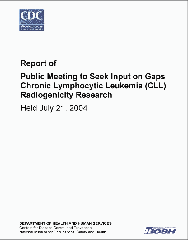Report of Public Meeting to Seek Input on Gaps in Chronic Lymphocytic Leukemia (CLL) Radiogenicity Research Held July 21, 2004
July 2006
DHHS (NIOSH) Publication Number 2006-100

Chronic lymphocytic leukemia (CLL) is the most common adult leukemia in the Western world. While the etiology of CLL is largely unknown, it is currently the only cancer assigned a probability of causation by ionizing radiation of zero under the US Energy Employees Occupational Illness Compensation Program Act (EEOICPA). In support of this decision many epidemiologic studies have shown no evidence of an association between external ionizing radiation and CLL. However, uncertainties remain, and recently new evidence was presented that suggest that this decision should be revisited (Richardson et al. 2005).
While the decision to treat CLL as non-radiogenic was based on a review of medically and occupationally exposed Western populations, additional studies may be informative. In the appropriations language for fiscal year 2004, the U.S. Congress directed the National Institute for Occupational Safety and Health (NIOSH) to conduct epidemiologic research and other activities to "establish the scientific link between radiation exposure and the occurrence of chronic lymphocytic leukemia." To this end, a focus on CLL radiogenicity was added to existing research conducted under the NIOSH Occupational Energy Research Program (OERP).
On July 21, 2004, NIOSH conducted a 3-hour public meeting to: 1) discuss available research strategies for investigating the potential relationship between the incidence of CLL and worker exposures to ionizing radiation and 2) identify gaps in current research. The meeting was announced in the Federal Register on June 10, 2004. This document summarizes the meeting proceedings and provides an updated report of related research activities.
2006-100.pdf [PDF - 498 KB]
- Page last reviewed: June 6, 2014
- Page last updated: June 6, 2014
- Content source:
- National Institute for Occupational Safety and Health Education and Information Division


 ShareCompartir
ShareCompartir